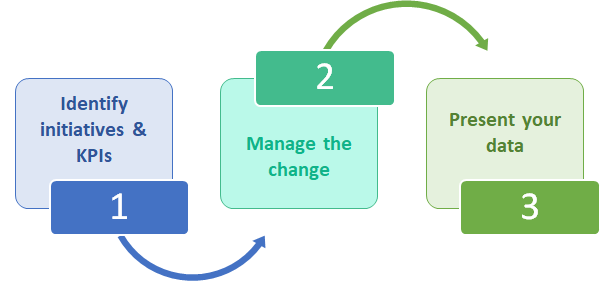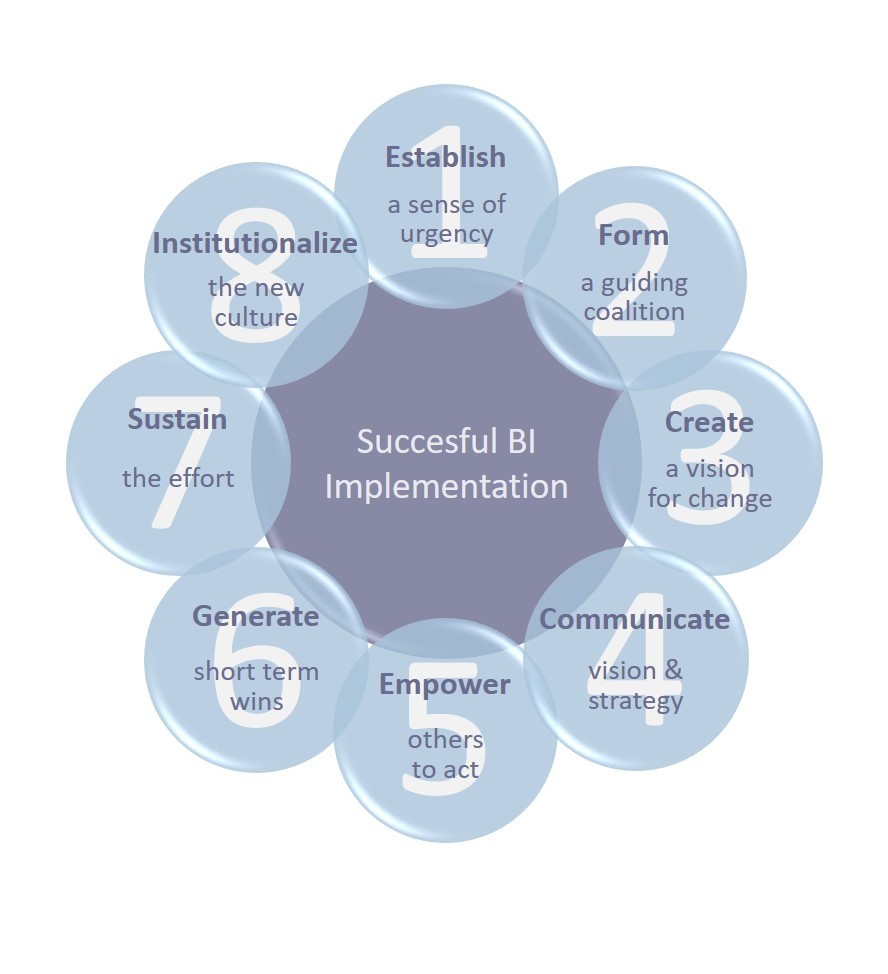Introduction

In our
previous article, Aligning BI and Strategy, we highlighted the main areas to address when
transforming your current measurement system into a management system, and how Microsoft Excel can help you reach this objective. However, we hardly said a word about the implementation process itself. This is step two of our triple focused approach:

Even if you have given a great deal of thought to what you want to achieve, and no matter what the scale of the challenge is, it is common to feel uneasy and intimidated by the business intelligence (BI) implementation project ahead.
Whether you are considering a small change just to one or two reporting processes, or a system wide implementation, the journey between the As-Is and the To-Be is extremely important. It is easy to overlook or discard excellent suggestions and strategy-supporting ideas when the change process is not well-managed.
Believe me, implementing, upgrading, or modifying any BI solution will introduce quite a few changes within your organization, and that change process needs to be handled properly. John Kotter, a guru in the fields of leadership and change, now enters the scene.
Kotter has formulated a very practical methodology for leading change. Although the methodology was originally designed to focus on strategy implementation, I like to rely on it to manage other change journeys as well. Implementing a BI tool is one such journey. Kotter articulates insights around eight clearly identified steps. This is how we apply those steps when implementing a BI Solution.
Kotter's 8 steps (applied to BI implementation projects)
 Step 1 - Establish a sense of urgency
Step 1 - Establish a sense of urgency

Few change processes come to a good end when there isn't any compelling reason or hurry to actually implement the change. It would be like setting out to renovate your perfect one-year-old kitchen: it makes absolutely no sense and you won't find anyone rallying to your cause. On the other hand, if your oven does not work anymore, your water faucet is leaking and your partner is getting depressed over the old-fashioned cabinets, then you know it is time to act, and you will. And your family members will help and support you, without asking.
Similarly, a sense of urgency is a powerful tool when commencing your BI initiatives. You should have a strong statement explaining the importance of acting immediately:
everybody needs to feel a change is needed in the short-term. There could be any number of reasons to hurry: financial, organizational, a lack of quality or reliability in your current reporting system, risks of being denied access to the market, a risk of losing face... You need to be convincing: identify threats, analyze opportunities and spark the initial motivation to get things moving. Once a substantial majority has been persuaded, the belief that the change is needed will feed upon itself. Don't jump too fast to step 2. During this first stage, establishing a sense of urgency is your foundation, and it needs to be very stable:
something must happen now.
Step 2 - Form a powerful guiding coalition

The guiding coalition will be the people who will support and push the project forward even when you're not around. They're ambassadors and warriors: they understand the importance of the BI project, will spread the word and want its implementation to be a success. This army will lead your implementation project and it should be built from within the ranks of the involved departments. Those same people will defend the choices made and explain why the new reporting will be setup in a given way.
This coalition is important and should be formed wisely: do not focus on established hierarchies but identify natural leaders, people to whom others look because of their knowledge, experience or strong personality and also people with different or creative ideas. Don't overlook those who offer themselves to be part of the team, as neglecting them can impair their future motivation. Still, not everyone can be part of this coalition. I recognize that this can be a difficult and delicate balance to achieve. As a rule of thumb, I would never recommend coalitions of more than eight people, and even that may be too many for smaller projects.
Step 3 - Create a vision for change and a strategy for achieving it
 Make the better future tangible.
Make the better future tangible. I have already emphasized the importance of this in my previous article
Aligning BI and Strategy.
Every BI project is always linked to your organization's strategy. I don't think there are exceptions. If, for instance, you measure the performance and quality aspects of any specific process in a chemical plant, that's because ultimately this supports the global strategy.
I'd like to reiterate the added value of using strategy mapping and balanced scorecards (and Excel) in this exercise. Not only can these tools be used at the company's top level, but they can be easily translated to every department in the organization. You'll discover that building the strategy map will be as valuable as the results it ultimately produces. The map allows you to crystallize your thinking and generates discussion until a consensus is reached.
The map shows how your BI solution contributes to achieving the company's objectives. A good map is synonymous with a strong foundation on which you can build. Co-create that map with your dominant coalition to shape the future.
Step 4 - Communicate vision and strategy

If you want people to rally to your cause, inform them. If you want people to be happy with what you're doing, listen to them (listening doesn't mean agreeing). Some theories say to repeat the same information seven times using seven different approaches. Well, use your common sense in how you communicate, but however you do it,
get people to buy in and get every stakeholder moving in the same direction. Communicate even when there's nothing to communicate. Just because there wasn't a lot of progress made during the holiday period doesn't mean that the message shouldn't be spread. Progress shouldn't be the only topic anyways. Keep the vision fresh in everyone's mind.
Step 5 - Empower others to act

To generate real impact, remove barriers (such as hierarchy), provide freedom, work across silos, involve people, create and plan for needed time, encourage nontraditional ideas and ask people what obstacles they are currently facing.
People need the resources and capabilities to work on the BI implementation. Check if there are processes or structures in their way. You need to provide everyone with the necessary resources and skills to perform the tasks required. People should be in the driver's seat to some extent. This will have a substantial impact on their motivation. They've set the objectives, you know their objectives are yours, and now they need the knowledge, the tools and the freedom to achieve them.
Step 6 - Generate short term wins
 And celebrate them!
And celebrate them! There is some low-hanging fruit out there: small Excel-based reports that can be produced, first management KPIs you can communicate, data integrations or consolidations the team can complete on a short-term basis... Identify those initiatives. Positive results need to be recognized, communicated and celebrated. Wins will energize people to persist in working on the BI implementation.
There are not a lot of things that motivate so well as success.
However, it's also always necessary to keep in mind that to pick the next level of fruit, someone may have to buy a ladder. Always keep the price of the ladder in balance with the potential return and regularly check it against your initial return on investment (ROI) analysis.
Step 7 - Sustain the effort
As the first results become tangible, don't start resting on your laurels too quickly. Real change runs deep. Instead, press even harder after the first successes. Your increasing credibility can improve systems, structures and policies.
Be relentless in initiating change upon change until the vision becomes the reality. Don't be happy with "it's good enough." What seems good enough as a dashboard today won't be tomorrow. Don't allow all the efforts you have made so far to be thrown into the dustbin because they didn't ultimately produce the expected results in the long run.
Step 8 - Institutionalize the new culture
Good habits should be maintained.
Articulate the connections between your new BI tool and organizational success. But, remember, as your strategy evolves, so must your BI environment. What you measure today might not be appropriate or needed tomorrow. If you have set some targets and they all have been reached, maybe it's time to define new ones isn't it? New targets will eventually mean that new data needs to be fetched and analyzed. After all, unless you are measuring the quality of a specific process,
what is the point of reporting a dashboard full of green smileys?
"Change is the only constant" - Heraclitus
As a conclusion...

My previous article,
Aligning BI and Strategy, explained that a complete BI solution should "prepare companies for the future", which means support the company's strategy. Hence the importance of choosing the right KPIs.
This article builds on those earlier insights by explaining how to manage the change process accompanying any BI implementation so that you can produce those desired KPIs. I hope that by following the above, you'll experience that you are able to
direct your employees' and colleagues' efforts to the areas where there are opportunities for your BI solution to have the greatest impact, rather than dispersing employees' initiatives across isolated and low-impact processes. This has the advantage of yielding results tangible for every level within the organization. At
Cintellis, we'll be more than happy to help guide you through the entire process. We offer solutions in Belgium, our home country, but provide remote services to customers located all over the world.



